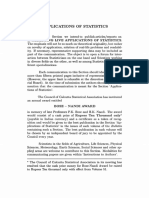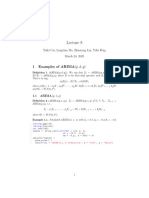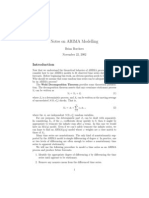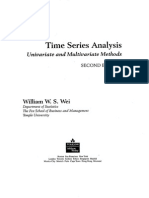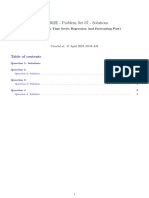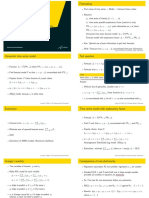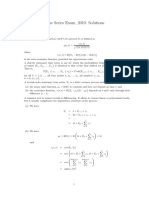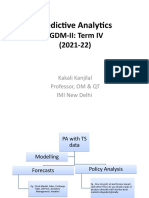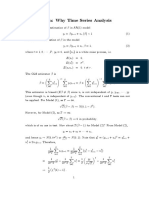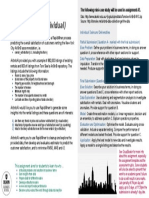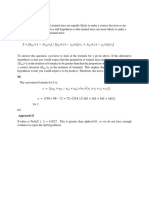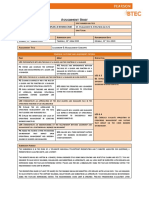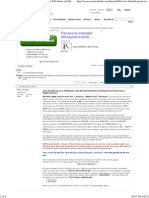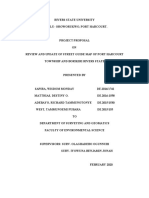Simple nonlinear time series models for returns∗
José Maria Gaspar
September 5, 2014
Econometrics II - Doctoral programme in Economics - FEP
1 A brief overview
Several time series in Economics and Finance present statistical properties that are
empirically time varying, i.e., the statistical law that drives the data in each regime
need not be the same. As a result, the possibility of having structural breaks may pose
as a serious problem of misspecification resulting in erroneous estimation, misleading
inference and poor predictions. To account for these issues, a few models have been
developed to be able to deal with these nonlinearities. A first class of models pertains
to the threshold autoregressive (TAR) models. The TAR is an AR(p) type with discon-
tinuities. The sudden shift in regime occurs when an observed variable jumps above a
certain threshold denoted as c. If the threshold variable is a lagged value of the time
series itself of order d and d = 1, then a self-exciting TAR (SETAR)1 with 2 regimes
and an AR(1) in both regimes is given by:
φ0,1
+ φ1,1 yt−1 + εt if yt−1 ≤ c
yt = (1)
φ0,2 + φ1,2 yt−1 + εt if yt−1 > c,
∗
This assignment was developed for the course of Econometrics II of the PhD programme in Eco-
nomics at the School of Economics and Management, University of Porto.
1
The regime is determined by the time series itself.
1
�which can also be represented as:
yt = (φ0,1 + φ1,1 yt−1 ) I[1 − yt−1 > c] + (φ0,2 + φ1,2 yt−1 ) (I[yt−1 > c]) + εt .
Generalizations of this model include changing the threshold variable or replacing the
indicator function I[yt−1 > c] with some continuous function. We thus obtain a more
gradual transition between any regime. Any such resulting model is called a smooth
transition (STAR) model. For instance, a fairly popular choice is to use the logistic
function:
1
G(yt−1 ; γ, c) = ,
1 + exp(1 − γ[yt−1 − c])
and replace it in the indicator function. We refer to this as the Logistic STAR (LSTAR)
model.
1.1 Estimation
The 2-regime STAR is given by:
yt = (φ0,1 + φ1,1 yt−1 ) It + (φ0,2 + φ1,2 yt−1 ) (1 − It ) + εt , (2)
where It = 1(qt−1 > c) is a known function of the data and qt is the threshold variable.
The model in (2) is a non linear regression and is discontinuous. To estimate it, we can
use sequential conditional least squares: (i) estimate φ0 s using LS for a given c; and (ii)
the LS estimate of c minimizes:
ĉ = arg min σ̂ε2 (c).
c∈[c,c̄]
Moreover, under ε ∼ iidN (0, σε2 ), then LS is equivalent to maximum likelihood estima-
tion. For further estimation and testing procedures, see Terasvirta (1994, JASA). For
either of the procedures, nonlinear estimation relies heavily on initial values.
For estimation of a LSTAR, there are problems with c and γ. When the latter is
large, we need many observations in the neighborhood of c to estimate γ accurately.
1.2 Testing and model selection
Testing for linearity in time series pertains to testing equality in the two regimes. Under
the null, we have H0 = φi,1 = φi,2 . Alternatively, we can express the null as γ = 0 which
2
�reduces the logistic function to 0.5 and the STAR model to an AR. Hansen (1996)
suggests using the following test statistic:
F = sup F [c],
c∈[c,c̄]
where
(σ̃ε2 (c) − σ̂ε2 (c))
F (c) = T ,
σ̂ε2 (c)
with σ̃ε2 (c) = (1/T ) (yt − yt−1 φ̃)2 . If one rejects the null hypothesis of linearity, then
P
one should proceed to choose G(.) and estimate the STAR model. Model selection and
parameter choice is usually based on the AIC, SBC, or the HQ criteria. A detailed
numerical example shall be illustrated in the next section.
1.3 Forecasting
We evaluate (2) at t = T + 1 and do recursive one-step predictions to obtain t =
T + 1, T + 2, ..., where θi,j , c is replaced by its point estimates. Consider the case where
yt is described by the general nonlinear autoregressive model of order 1,
yt = F (yt−1 ; θ) + ε,
for some nonlinear function F (.). When using a LS criterion, the optimal point forecasts
of future values of the time series are given by their conditional expectations and the
one-step ahead forecast is ŷt+1|t = F (yt ; θ). Two or more step ahead point forecasts is
far more complicated. For a well referenced documentation on this point, see Franses
and van Dijk (2000).
2 Numerical application
In this section I shall present a numerical illustration of the models discussed in the
previous section, along with the procedures required for the usual tasks in time series
analysis. For this purpose, I use the tsDyn package for nonlinear time series modelling
available in R-Project. For all the available linear and nonlinear models in the package
one needs only to run the command availableModels() once the package is loaded.
3
�2.1 Data
The simulation is based on the univariate data set (U sU nemp) from Caner and Hansen
(2001) containing monthly data for US adult male unemployment rate spanning from
1956:M1 to 1999:M8.
2.2 Nonlinear models for US Unemployment
Figure 1 plots the time series U sU nemp, and the ACF plus the PACF for the time series.
Although it is not clear cut from the picture, it already seems to evidence the existence
Figure 1 – Plot, ACF and PACF of yt = U sU nempt .
of some structural breaks. Before proceeding with estimation, the next step will be to
test for linearity in the series. This can be done with the delta.lin.test command
4
�in the tsDyn package available in R. Assuming embedding dimensions m from 2 up to
5, the linearity test results are reported in table 1. The results are ambiguous as the
eps
m
0.7979 1.5958 2.3938 2.3938
2 0.30 0.12 0.22 0.52
3 0.02 0.02 0.58 0.12
4 0.02 0.08 0.04 0.22
5 0.18 0.02 0.26 0.64
Table 1 – Linearity test results. Middle values are reported p-values. eps repre-
sents different length scales and m are different dimensions.
p-values differ greatly depending on the embedding dimension and length scales. But
for the sake of our purposes, and knowing in advance the results from model selection
criteria, let us reject the null of linearity at the 5% significance level.
Next, I estimate different STAR models. For the sake of comparison, I shall begin
by estimating a simple AR(2) model. The R estimation output is as follows:
Non linear autoregressive model
AR model
Coefficients:
const phi.1 phi.2
0.04863972 1.14281890 -0.15273731
Next, we estimate a SETAR(2,2) with time delay d = 1, whose reported results are
given by the following output:
Non linear autoregressive model
SETAR model ( 2 regimes)
Coefficients:
Low regime:
const.L phiL.1 phiL.2
-0.0006888229 0.9560012261 0.0486719125
High regime:
5
� const.H phiH.1 phiH.2
0.03465109 1.28923101 -0.29769290
Threshold:
-Variable: Z(t) = + (0) X(t)+ (1)X(t-1)
-Value: 4.978
Proportion of points in low regime: 60.15% High regime: 39.85%
Finally, we estimate a LSTAR with the same configurations. The output can be
easily checked by running the commands in the script file. If we assign mod to be a
list containing each of the three estimated models, the sapply(mod,AIC) command
computes the AIC criterion for each one of the models. The reported values are given
in table 2. Though the AIC is close for the SETAR and LSTAR models, I opt for the
linear SETAR LSTAR
AIC -1660.848 -1669.549 -1667.143
Table 2 – Model selection using AIC. The SETAR model seems the more appro-
priate.
SETAR as a more suitable model based on the results of table 2.
After choosing the model we are going to work with, the tsDyn package contains
a very useful function that helps choosing the best parameters for the model, such as,
e.g., the number of autoregressive polynomials for each regime, the threshold delay d
for the threshold variable, and the threshold c. Let us assume there are at most 3 AR
polynomials in each regime (m ≤ 3) and that d ≤ 2. Inserting this in the function
selectSETAR(), we get the following results:
Using maximum autoregressive order for low regime: mL = 3
Using maximum autoregressive order for high regime: mH = 3
Searching on 363 possible threshold values within regimes with
sufficient ( 15% ) number of observations
Searching on 9801 combinations of thresholds ( 363 ),
thDelay ( 3 ), mL ( 3 ) and MM ( 3 )
Results of the grid search for 1 threshold
thDelay mL mH th pooled-AIC
1 0 1 3 3.845823 -245.4812
6
�2 0 1 3 3.844265 -244.8682
3 0 1 3 3.671880 -244.5442
4 0 1 3 3.828556 -244.2263
5 0 1 3 3.836013 -244.0534
6 0 2 3 3.845823 -243.9030
7 0 1 3 3.863612 -243.8684
8 0 1 3 3.856234 -243.6822
9 0 1 3 3.661763 -243.6590
10 0 1 3 3.817562 -243.6098
Figure 2 – Pooled AIC for each c after a grid search.
From figure 2 and the results above we choose to estimate a SETAR with m = 3,
mL = 1, mH = 3, d = 0, and c = 3.845823, based on the pooled-AIC, where mL and
mH are the number of AR polynomials for the low and high regimes, respectively.
The estimation results of our new SETAR model are as follows:
Non linear autoregressive model
SETAR model ( 2 regimes)
Coefficients:
Low regime:
const.L phiL.1
0.01124622 1.00085091
High regime:
7
� const.H phiH.1 phiH.2 phiH.3
0.09456131 1.10669723 0.21194097 -0.33680573
Threshold:
-Variable: Z(t) = + (1) X(t)+ (0)X(t-1)+ (0)X(t-2)
-Value: 3.846 (fixed)
Proportion of points in low regime: 25.91%
High regime: 74.09%
Residuals:
Min 1Q Median 3Q Max
-1.022366 -0.129020 -0.014286 0.107983 0.760483
Fit:
residuals variance = 0.03721, AIC = -1713, MAPE = 3.21%
Coefficient(s):
Estimate Std. Error t value Pr(>|t|)
const.L 0.011246 0.084584 0.1330 0.894277
phiL.1 1.000851 0.027611 36.2489 < 2.2e-16 ***
const.H 0.094561 0.043720 2.1629 0.031006 *
phiH.1 1.106697 0.045341 24.4083 < 2.2e-16 ***
phiH.2 0.211941 0.069233 3.0613 0.002318 **
phiH.3 -0.336806 0.044952 -7.4925 2.94e-13 ***
---
Threshold
Variable: Z(t) = + (1) X(t) + (0) X(t-1)+ (0) X(t-2)
Value: 3.846 (fixed)
We also re-estimate the linear and LSTAR models with the same specifications
and reapply the sapply(mod,AIC) command just to arrive at the conclusion that the
SETAR is still a better fit.
8
� I have also ran a forecasting examply using the data, which can be applied running
the script file in R. An interesting task can be inspecting the fitted model skeleton.
This can be achieved by computing the forecasting results under each model. Figure 3
contains fitted model skeletons for the AR, SETAR and LSTAR models. The skeleton
Figure 3 – Fitted model skeletons. From left to right: AR, SETAR and LSTAR
models.
models show no evidence of a stationary solution. In fact, they all show divergence.
This could, however, be a consequence of the strong evidence of presence of unit roots
in the AR polynomials, something which I have conveniently dismissed for the sake of
brevity in this discussion.
3 Concluding remarks
I have briefly described the main models used to fit time series that evidence strong
non linearity. This strong non linearity stems mainly from discontinuities in different
regimes. The models discussed fall into the class of the Threshold Autoregressive (TAR)
models. A change in a regime occurs when a certain variable falls or jumps above a
certain threshold. If that variable is the observed variable itself, we have the particular
case of self exciting TAR (SETAR) models. If the threshold variable is some continuous
function, we call the model a smooth transition (STAR) model. Nested in the latter
is the logistic LSTAR (model), the case in which the function is of the logistic type.
We have seen that testing for linearity is tantamount for testing equality of parameters
under different regimes. We have also seen that forecasting for more than two periods
ahead can be quite difficult for nonlinear models.
We have completed this assignment by running a simulation in R using data on US
Unemployment from 1956 to 1999. We have compared linear models to SETAR and
9
�LSTAR models and found that the SETAR fits the data comparably better.
References
[1] Caner and Hansen B. (2001), “Threshold autoregression with a unit root Econo-
metrica”, 2001, 69, 1555-1596.
[2] Franses, P.H. and Dick v. D. (2000) “Nonlinear Time Series Models in Empirical
Finance”, Cambridge: Cambridge University Press.
[3] Hansen, B. (1996) "Inference When a Nuisance Parameter Is Not Identified under
the Null Hypothesis," Econometrica, 64(2), 413-30.
[4] Terasvirta (1994), "Specification, Estimation and Evaluation of Smooth Transition
Autoregressive Models", JASA, vol 89, pp 208-218
10
















